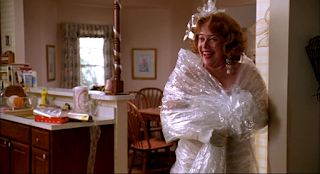 |
| Charles Blondin |
Today, The Grandma has been watching Niagara, the classic thriller interpreted by Marilyn Monroe and Joseph Cotten. It is an amazing film that supposed the beginning of the successful career of Marilyn Monroe.
Meanwhile The Grandma was watching the final scene; she has remembered an incredible event. In 1859, French acrobat Charles Blondin crossed Niagara Falls on a tightrope. It was something amazing never seen it before.
The Grandma wants to remember who Charles Blondin was and his exciting career.
Charles Blondin (born Jean François Gravelet, 28 February 1824-22 February 1897) was a French tightrope walker and acrobat. He toured the United States and was known for crossing the 340 m Niagara Gorge on a tightrope.
During an event in Dublin in 1860, the rope on which he was walking broke and two workers were killed, although Blondin was not injured.
He married three times and had eight children. His name became synonymous with tightrope walking.
Blondin was born on 28 February 1824 in Saint-Omer, Pas-de-Calais, France. His birth name was Jean-François Gravelet, though he was known by many other names and nicknames: Charles Blondin, Jean-François Blondin, Chevalier Blondin, and The Great Blondin.
At the age of five, he was sent to the École de Gymnase in Lyon and, after six months of training as an acrobat, made his first public appearance as The Boy Wonder. His superior skill and grace, as well as the originality of the settings of his acts, made him a popular favourite.
More information: Smithsonian Magazine
Blondin went to the United States in 1855. He was encouraged by William Niblo to perform with the Ravel troupe in New York City and was subsequently part proprietor of a circus. He especially owed his celebrity and fortune to his idea to cross the Niagara Gorge on the Canada–US border on a tightrope, 340 m long, in 8.3 cm in diameter and 49 m above the water, near the location of the current Rainbow Bridge.
This he did on 30 June 1859, and a number of times thereafter, often with different theatrical variations: blindfolded, in a sack, trundling a wheelbarrow, on stilts, carrying a man his manager, Harry Colcord on his back, sitting down midway while he cooked and ate an omelette, or standing on a chair with only one of its legs balanced on the rope.
 |
| Charles Blondin |
On 23 August 1860, he performed at the Royal Portobello Gardens, on South Circular Road, Portobello, Dublin, on a rope 15 m feet above the ground.
While he was performing, the rope broke, which led to the collapse of the scaffolding. Blondin was not injured, but two workers who were on the scaffolding fell to their deaths.
While he was performing, the rope broke, which led to the collapse of the scaffolding. Blondin was not injured, but two workers who were on the scaffolding fell to their deaths.
An investigation was held, and the broken rope reportedly 5 cm in diameter and 13 cm in circumference examined. No blame was attributed at the time to either Blondin or his manager; the judge said that the rope manufacturer had a lot to answer for.
The organiser of the event, a Mr. Kirby, said he would never have another one like it. A bench warrant for the arrest of Blondin and his manager was issued when they did not appear at a further trial, having returned to the US.
In 1861, Blondin first appeared in London, at the Crystal Palace, turning somersaults on stilts on a rope stretched across the central transept 21 m from the ground. He performed in September 1861 in Edinburgh, Scotland, at the Royal Botanic Gardens then called the Experimental Gardens on Inverleith Row.
The following year, Blondin was back at the same venue in Dublin, this time performing 30 m above the ground. He gave a series of other performances in 1862, as well, again at the Crystal Palace, and elsewhere in England and Europe.
More information: Mental Floss
On 6 September 1873, Blondin crossed Edgbaston Reservoir in Birmingham. A statue built in 1992 on the nearby Ladywood Middleway marks his feat.
While he was living in England, he and Charlotte had two more children, Henry, born c. 1863, and Charlotte Mary Janet, baptised on 25 April 1866.
After a period of retirement, Blondin reappeared in 1880 and starred in the 1893–94 season of the pantomime Jack and the Beanstalk at the Crystal Palace, organised by Oscar Barrett. His final performance was in Belfast, Ireland in 1896.
Blondin died of diabetes at his Niagara House in Ealing, London, on 22 February 1897, at age 72 and was buried in Kensal Green Cemetery.
During his lifetime, Blondin's name became so synonymous with tightrope walking that many employed the name Blondin to describe others in the sport.
More information: Ripleys
Only those who will risk going too far
can possibly find out how far one can go.
can possibly find out how far one can go.
T. S. Eliot
















